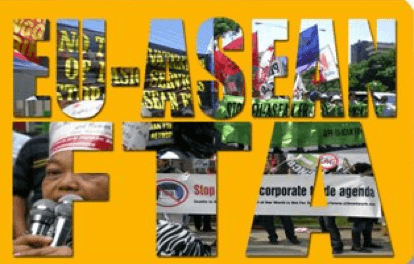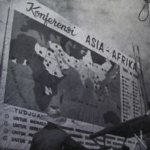Aileen Kwa,
Geneva, June 2007
Developed countries’ pretense that the Doha Round will deliver on ‘development’ has fallen by the wayside. The Round was never launched to deliver on development in the first place. As an Asian delegate to the WTO quipped recently, “‘Development’ was in 50-60 places in the Doha text. Do you see it now in the negotiating texts?” (He was referring to New Zealand Ambassador and Chair of the Agriculture negotiations, Crawford Falconer’s “Challenge” papers).
Both the recent process of negotiations at the WTO, as well as the substance of the negotiations have failed developing countries. In fact, the “multilateral” process conducted in Geneva in the recent weeks has been described in WTO corridors, by developing negotiators themselves as “farcical”. The real negotiations had been taking place between the G4 (US, EU, Brazil and India). Director General, Pascal Lamy had even told the Chairs of agriculture and non-agricultural market access (NAMA) to withhold issuing draft modalities texts until after the planned week-long Potsdam G4 Ministerial meeting which got underway on 19 June, and which broke down on the third day. The plan had been to wait for the G4 to come up with their package, weave that into the draft texts of the Chairs so that the G4 package is made more palatable to the other Members, hold a series of quick Green Room discussions between 20-35 delegations in Geneva, bring a selected number of Ministers (by invitation only) to Geneva at the end of July, and viola, stitch the Round together.
In response to being marginalized, the “G90 plus”, comprising of the African Group, ACP (African, Caribbean and Pacific) countries, LDCs, and Bolivia and Venezuela, came together yesterday to publicly denounce such a process. In their press conference, the G90 plus declared that “development concerns have been left behind in the rush to agree to a deal in the Doha Round”.
Remarked Jamaica’s Ambassador, Gail Mathurin, Chair of the ACP countries, “If the Round is to be completed, the concerns of developing countries must be dealt with. But (our) critical issues have been marginalized or left behind as the negotiations proceeded.”
Quoting from the G90 plus declaration, Mathurin went on to state that “The recent WTO negotiating process has been “less than transparent and participatory”… The majority of Members have little or no knowledge of the progress and content of the G4 process. Although two of the G4 members are developing countries, they cannot be expected to carry the responsibility of representing the views of all developing countries”.
“The groups (ACP, LDCs, African Group plus) are concerned they may be faced with texts they are asked to consider at very short notice… The multilateral system cannot be used to rubber stamp and legitimize decisions made by a few”.
US and EU Hypocrisy and Unreasonable Demands in the Talks
At the heart of the breakdown in talks is the fact that the developed countries, particularly the US and EU continue to act as if they are still the colonial masters of the day. A Middle Eastern delegate privately commented, “The developed countries want the whole cake. You give me, I don’t give you”.
The US and EU have been exacting on developing countries. In agriculture, they have been deaf to developing countries’ concerns of food security and rural livelihoods. What is worse, the Chairman of the agriculture negotiations, New Zealand’s Ambassador Crawford Falconer, has promoted positions that give advantage to US / EU positions, whilst downplaying developing countries’ proposals. One G33 (a coalition of 46 developing countries at the WTO) negotiator characterised Falconer’s recent Challenge paper (30 April 2007) as follows: “The SP (Special products) and SSM (Special Safeguard Mechanism) issues have been given step-mother treatment”.
US and EU are also asking developing countries to do more in NAMA, than they would liberalise themselves. They have asked for developed countries to have a swiss coefficient of 10, and developing countries a coefficient of 15. As the NAMA 11 coalition of developing countries recently pointed out, a coefficient of 10 for developed countries would bring down developed countries’ average bound tariffs from 6.8 percent, to 4%, a 40.4% reduction. However, a 15 coefficient for developing countries would bring the NAMA 11 developing countries’ average tariff down from 34.4% to 10.4%, a 69.9% tariff reduction. The NAMA 11 coalition has asked for a fairer deal, proposing a coefficient of 35. This would bring down their tariff from 34.4% to 17.3%, a percentage cut of 49.5%. This is still higher than the 40.4% cut that would be undertaken by developed countries. For the NAMA 11, this is the only way Members will come close to abiding by their commitment of “less than full reciprocity”, a principle agreed in the Doha declaration i.e. developed countries have to undertake tariff larger cuts than developing countries. US and EU in the Potsdam G4 Ministerial meeting rejected this proposal, and blamed Brazil and India for changing the goal posts in the end stretch of the game.
Even as these demands are made of developing countries, both US and EU have joined hands to maintain the status quo on agricultural trade distorting domestic supports. The fight is not merely a theoretical one. Lives at put at risk as developing countries are told to lower their trade barriers and allow the entry of subsidized imports. According to data from the Institute for Agriculture and Trade Policy, in 2003, soybeans from the US were exported at 10 percent below their cost of production; corn at 10 percent below cost, cotton at 47 percent; and rice at 26 percent below production costs. US subsidies to rice producers amounted to 1.3 bn for rice that cost 1.4 bn to grow. In Indonesia, the import of subsidized soy sent shockwaves through the domestic sector. Between 1996 and 2001, half of the 5 million soy producers were wiped out. In Ghana, rice imports doubled between 1998 and 2003, increasing poverty amongst food crop farmers. 66 percent of producers recorded either negative returns or job losses.i US subsidized rice has also hit rice producers in the Gambia and Tanzania.
Both US and EU’s subsidized poultry exports have wiped out the domestic poultry production in many countries. According to the FAO, developing countries experienced 669 cases of poultry import surges from 1983 to 2003. The situation is particularly acute in Africa. Even though the continent accounts for only 5% of global poultry trade, 50% of these import surges have occurred there.ii 70% of the Senegal poultry industry has been lost in recent years and 90% Ghana’s local poultry production has been wiped due to poultry imports from US, EU and Brazil.iii In Cote d’Ivoire, FAO reports 15 000 job losses in the sector between 1997 and 2004 as a result of poultry imports. iv
According to Canadian sources, US’ so-called “overall trade distorting” domestic supports (OTDS) amounted to 10.8 billion in 2006. Oxfam America projects that by 2007, due to high world prices as a result of the biodiesel gold rush, these supports could be down to 6.5 billion. Yet the US continues to argue for the leeway to provide up to as high as 17 billion in OTDS – nearly three times the amount they would actually use this year!
Note that these figures are seriously minimized. Analyst Jacques Berthelot contends that there is a lot of cheating going on in terms of what is housed under the OTDS -for instance, irrigation and feed subsidies have been excluded. What has also recently surfaced is that up to 6 billion in tax supports for ethanol processors is not recognised by the US as agricultural subsidies.v
Over and above the OTDS, the US provides supports to the tune of 50 billion via the WTO undisciplined, uncapped and unlimited “Green Box”.
The EU is playing the same Green Box game. As export subsidies and other forms of trade distorting supports are being reduced, the EU is shifting up to 30 billion Euros into the Green Box. This is provided to EU producers through their supposedly ‘decoupled’ Single Payment Scheme. In time, according to Peter Mandelson, 90% of their supports will be housed in the Green Box, which the WTO’s own litigation has declared as trade distorting.vi
Indeed, the EU’s 2002 CAP reform phased out export subsidies. Internal prices are now much lower, especially on grains, but the decoupled payments to producers help compensate for their high production costs i.e. when these grains are exported, decoupled payments are effectively the new generation of export subsidies. What is the impact of decoupled payments on production? In some sectors eg. beef, some reduction in quantity is anticipated. However, in other sectors, such as grains and dairy, production is likely to even increase! What will this mean for exports? According to Tobias Reichert’s study on the Common Agricultural Policy, “For wheat and coarse grains, increased EU exports are predicted. Whole milk powder exports are expected to remain the same.” Reichert also concludes that through the Single Farm Payment, most farmers will receive the same levels of support as before the reform.vii
What is alarming is that both the EU and US have insisted on leaving the Green Box untouched and undisciplined in the current Round – and from his Challenge paper of 25 May, the Agriculture Chair Crawford Falconer seems to support such a position! A chorus of protests is rising on this issue – now not only from the G20 but also the G90 plus countries. In their 21 June declaration, the G90 plus countries state, “There must be new disciplines for the use of the Green Box subsidies by developed countries to ensure they are really non trade-distorting…”. viii
Big Bang Liberalisation Has Not Worked for Development
Let’s cut to the chase. The WTO’s liberalization formula will not work for development, and much less, the greed of the US and EU in demanding ever more aggressive market access. What is often shoved under the carpet is that the WTO’s own preamble states that trade “should be conducted with a view to raising standards of living, ensuring full employment and a large and steadily growing volume of real income and effective demand…”.
Trade liberalization – according to cookie cutter formulas and time lines instead of being based on countries’ own economic strategies, needs and pace – simply cannot deliver on ‘raising standards of living’ and ‘full employment’. The structural adjustment experience of developing countries in the last 25 years is indicative. Most developing countries (excluding some of the Asian countries that had a headstart and which implemented heavy government regulation) saw their industries contract, even the countries which increased their exports either stagnated or deindustrialised eg. Mexico and Chile. In Mexico, between the late 1980s and through the 1990s, manufactured exports grew quickly – nearly 30 percent – in part due to the passage of the North American Free Trade Agreement (NAFTA). However, according to former UNCTAD economist S.M. Shafaeddin, manufactured value added (MVA) “did not accelerate, and upgrading of the industrial base did not take place”. Chile is usually portrayed as the success story in Latin America. However, even after 25 years of reform, there has been little upgrading of its industries beyond the expansion of natural resource based industries such as wood and chemical products. Even more alarming, Jamaica, Ghana, Colombia, Uruguay and Paraguay have all experience high or moderate levels of growth rates in exports, but have had negative growth rates in manufactured value added (MVA). “Notwithstanding two decades of reform, Ghana’s growth in MVA added was significantly negative, registering -3.5% during the 1990s, implying severe deindustrialization”.ix
The failures of liberalization has perhaps been most stark in Sub-Saharan Africa. According to the World Bank, “Sub-Saharan Africa failed to take off despite significant policy reform improvements in the political and external environments, and continued foreign aid. The successes were few – with Uganda, Tanzania and Mozambique the most commonly cited instances – and remained fragile more than a decade later”. x
According to UNCTAD’s most recent Least Developed Country (LDC) report,
“In recent years, many LDCs have achieved higher rates of economic growth than in the past and even higher growth of exports. But there is a widespread sense – which is apparent in the concern to ensure “pro-poor” growth – that this is not translating effectively into poverty reduction and improved human well-being”. The report goes on to state that the incidence of poverty did not decline in the 1990s in LDCs as a group, and has remained at 50% of the total population. If this trend continues, the number of people living in poverty in LDCs will increase from 334 million in 2000 to 471 million by 2010.xi
UNCTAD cites Comoros, Malawi, Mali, Tanzania and Zambia as countries where GDP per capita growth has not translated into higher consumption per capita – i.e. there has been no poverty reduction.xii
No Tears Over Doha’s Demise
If the G4 collapse spells the end of the Doha Round, no tears should be shed. It was never intended by the developed countries to deliver on development. Even the one issue many developing countries are angling to obtain – a cut in trade distorting domestic supports, and a phase out of export subsidies- will not happen. The EU itself projects increases in production in grains and dairy. The same amount of money is being provided to the same producers, but now simply labeled as decoupled and ‘Green’. Export dumping continues without so much as a hiccup. US “trade distorting supports” this year may be about 6.5 bn, but they want to cap their supports at 17 bn. Are we losing anything? The bulk of the payments will be washed green. Small wonder that the US and EU want to keep the Green Box sacred and intact, unlimited and undisciplined.
What about the multilateral trading system? Will it also collapse and should we be worried? The WTO has proven itself to have a splendid ability over the past 11 years to marginalize developing countries, and especially during its most critical negotiations! In substance, its liberalization agenda simply cannot and will not deliver on development. The past 25 years of structural adjustment should have taught the international community that lesson.
Developing countries would do well with a new multilateral trade system. One that regulates trade and ensures it is fair, rather than acts as an enforcer of liberalization, especially of developing countries. What does this mean? We need a system that can be the whistle blower, disciplining countries that dump on others and warning affected countries when dumping occurs. The system should also regulate corporate size, behavior and transparency. Multilateral trade regulation should outlaw the corporate abuse of transfer pricing and predatory market practices. As there are in domestic competition laws, there should be certain disciplines and limits put on the size of corporations when they venture abroad. Thirdly, instead of attempting (and only half-heartedly) to liberalise agricultural trade, which will benefit only the most competitive, and penalize millions of poor farmers across the developing world, we need a multilateral system that supports commodity agreements so that prices and supplies can be regulated and matched with demand. This is not only for tropical commodities – coffee, tea, cocoa – but also for major staple products such as grains and dairy, which currently suffer from over-supply from the major agricultural producing countries, resulting, as in the case of the US and EU, in dumping.
This is a radical overhaul of the system, but one that at least has a fighting chance of offering real development to a large number of countries which, under duress to liberalise, are today simply floundering in their attempts at economic development.
i ActionAid 2006 ‘Agro-Import Surge Study: The Case of Rice in Ghana’, August, ActionAid International Ghana.
ii FAO 2007 “Commodities No. 1 Import Surges in Developing Countries: the case of poultry”, FAO Briefs on Import Surges.
iii In the US, corn and soy have been the two most heavily subsidized crops in US commodity programmes. Around 55-65% of corn and 45-50% of soy production go to the domestic livestock industry as feed and feed costs account for 60-64% of poultry and egg costs. Feed prices for poultry are estimated to be 21% below production costs. This has landed the US broiler chicken industry cumulative savings of 11.25 bn between 1997 and 2005. (Fatka J 2007 “Broiler, Hog Industries Save Billions from Corn”, Feedstuffs, March 25 Issue 13 Vol. 79.) Jacques Berthelot has estimated that EU subsidization of poultry is at an annual average of 329 million Euros for the 1.043 billion Euros in EU poultry exports i.e. a dumping rate of 24% (Berthelot J 2007 “The Agricultural Negotiations at the WTO: Mechanisms and Tricks”, April).
iv FAO 2007g ‘FAO Briefs on Import Surges. Countries No. 12. Insights on Rice, Poultry and Sugar Imports into Cote d’ Ivoire’.
v Personal communication with a WTO member of the G20.
vi In the cotton case, the Panel ruled that US green box payments did not belong there because they were tied to production conditionalities (producers were not allowed to plant fruit, vegetables and wild rice), leading to production distortions. Posing an even greater challenge to the fundamental character of the Green Box, the Appellate Body in the Dairy Products of Canada case, in its 3 December 2001 report stated that
“We consider that the distinction between the domestic support and export subsidies disciplines in the Agreement on Agriculture would also be eroded if a WTO Members were entitled to use domestic support, without limit, to provide support for exports of agricultural products. Broadly stated, domestic support provisions of that Agreement, coupled with high levels of tariff protection, allow extensive support to producers, as compared with the limitations imposed through the export subsidies disciplines. Consequently, if domestic support could be used, without limit, to provide support for exports, it would undermine the benefits intended to accrue through a WTO Member’s export subsidy commitments (para 91)… The potential for WTO Members to export their agricultural production is preserved, provided that any export-destined sales by a producer at below the total cost of production are not financed by virtue of governmental action (para 92)”.
vii Reichert T 2006 “A Closer Look at EU Agricultural Subsidies”, Germanwatch. http://www.germanwatch.org/tw/eu-agr05e.htm
viii Their declaration continues, ‘Green Box subsidies especially those provided as decoupled income support, insurance against income loss and investment aid, should be subjected to eligibility criteria such as low levels of income, status as a producer or landowner, landholding and production level, in a fixed and unchanging base period’. ACP Group, Africa Group, LDCs, Bolivia and Venezuela, 21 June 2007, “Declaration on Development Concerns and Issues in the Current WTO Negotiations”.
ix Shefaeddin S.M. 2005 “Trade Liberalisation and Economic Reform in Developing Countries” Structural Change of De-Industrialisation?”, UNCTAD Discussion Papers No. 179, April.
x World Bank 2005 “Learning from Reform”, cited in Rodrik D 2006 “Goodbye Washington Consensus, Hello Washington Confusion?”, Harvard University, January.
xi UNCTAD 2006 LDC Report p. 31.
xii UNCTAD ibid.







